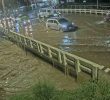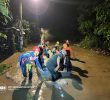DAVAO CITY – The Climate Change Commission echoed previous warnings by global environment organizations that Mindanao is likely to be hit by an extreme drought six years from now, or to be exact on year 2020, due to rapid climate changes happening in the country.
“Based on rainfall forecast of Pagasa, Mindanao by year 2020, some or if not most areas, will experience a reduction of rainfall and this will cause an extreme drought which will be felt from March to August,” Secretary Mary Ann Lucille Sering warned here on Monday.
Sering, the vice-chairperson of the Climate Change Commission, disclosed the forecast before reporters attending the Climate Change Media Workshop at the Royal Mandaya Hotel here.Sering said the 2011 Climate Change Vulnerability Index placed the Philippines sixth among countries categorized in “extreme risk” and with “weak infrastructures and high number of risks and exposed to risks.”
“The people of Mindanao, as early as now, should prepare for this scenario to mitigate its impact especially on health, food, security and livelihood of the people,” she said.
“During extreme dry season, the agricultural sector suffers from the said drought,” Sering said.
Lack of knowledge
Sering said however, that weather and climate warnings and information may be largely unheeded as she noted a lack concrete understanding among many people in Mindanao of what climate change is all about.
She said that “national and local politicians, businessmen and even journalists who report on the issue lack the correct knowledge of climate change”.
“People have personally felt the effects of climate change, and yet most of them have little understanding of it,” she said.
A 2013 Climate Change Awareness survey by the Social Weather Stations (SWS) and commissioned by the World Bank bared that eight out of ten Filipinos claimed to have “personally experienced” the impact of climate change in the last three years and 54 percent described their experience as “severe” to “moderate”. Thirty-one percent said they only little experience.
“There was already lots of attempt for them [LGUs] to integrate the climate change and disaster risk reduction in their plans but they need more support because it requires a lot of science-based planning and not most of the LGUs have this capacity,” Sering said.
Sering said the media industry plays an important role “because any information has to be reported the right way in as much as we want people to be alarmed and we don’t want to scare them..The media should serve as an early warning system”.
“Media should catch on because this is no longer a problem of the poor, it is also the problem of the rich who have businesses and it is a problem of everybody. And it no longer is a problem of an 80-year old it is much as a problem of those unborn.”
Climate change out of development plans
Sering also disclosed that climate change was never made part of government’s development plan until the strong typhoons pounded the country.
“Climate Change was never in the Philippine Development Plan during the previous administrations and because of typhoons Ondoy and Pepeng that hit the economic center of the country, the response was almost immediate and on the same year 2009, the Climate Change Act was passed.”
“In short, the Philippines was only aware of the concept of climate change because both Senate and Congress have enacted climate change laws. But the rest of the government and the media there was no concrete understanding of what climate change is when it was already discussed since 1990s.”
“It took so long to evolve our understanding of the impacts of climate change to think Philippines is one of the vulnerable countries in the world. So it manifested that the whole time we are talking about it and it did not mainstream in our national policy; that the media didn’t talk about it; that we’ve been hit by so many strong typhoons because it took so long this agenda was finally passed on.”
Sering blamed the “subsume” structure of the Climate Change Cluster of why there’s this little awareness of climate change or the lack of it in the government’s bureaucracy”.“The Climate Change Cluster is headed by the DENR chief while the Climate Change Commission sits as a Secretariat. The problem with this set-up is you have a chair who is an Environment Secretary whose focus in only on the environment when the subject matter is already cross-sectoral so the tendency is the issue is always about the environment for the past 3 years,” Sering said.
“The structure of the Climate Change Commission is really under the Office of the President as we are given a fix term of 6 years to monitor, evaluate all climate change programs across sectors.
Structurally, it became subsumed under the environment agenda.”
The ‘new normal’
Sering said that Mindanao used to be a typhoon-free island but with erratic climate changes, Mindanao has not been spared from the wrath of even stronger typhoons such as Ondoy, Agaton and Pablo.
Climate Change expert, Dr. Rosa T. Perez, said that climate change will have adverse effects on agriculture, forest and biodiversity, health, marine resources and energy.
For instance, Mindanao’s power supply would suffer heavily as the heat would dry up the hydroelectric sources. This would mean it has to rely more on imported coal and oil.
Perez said that the country has achieved only two types of actions in terms of levels of climate change adaptation, namely: resilience-building and climate-proofing.
Resilience-building is about addressing the adaptation deficit, such as to diversify livelihood activities according to the variable conditions of the place. It also ventures into crop insurance and other agricultural innovations on irrigation, as well as adapt seasonal forecasting and early warning systems to reduce the effects of disasters.
Climate-proofing is adapting to incremental changes by strengthening structures and natural shields and protections. This would include upgrading drainage systems to accommodate greater runoff, adapting shorter cropping systems in areas with more frequent visits of natural disasters, and estimating periods of greater water stress and heat extremes.
Perez is a consultant of the Intergovernmental Panel on Climate Change Technical Working Group.
Coal, solar power
According to Sering, the Philippine carbon emission is below one percent when compared to develop countries and claimed that Philippines is a natural carbon sink because of trees absorbing carbon emissions.
However, Sering warned that using coal power plants to generate power would consume tons of water to produce the desired power supply capacity. Yet, she was not categorical as the stand of the commission on the influx of coal power plants in Mindanao.
Sering said “the role of the government is to provide an environment where private sectors can invest. Right now, we have a renewable energy law and there are incentives that are in place”.
“What we are saying is, we wanted to push more investments if private sectors opt not to invest in the renewable energy although we are supporting it because we have a law, it is also difficult for us. What we wanted to say is that they should also consider not just the cost of putting it up but also the other costs such as the availability of water.”
“As far as the national government is concerned, we already have the incentives in place and this is a free-enterprise and we are encouraging more investors to go for renewable but also hopefully, that this will be cheaper,” Sering added.
But Dr. Jean Lindo, co-convenor of No To Coal Davao Coalition, contested Sering”s claim saying that the Philippines is not carbon sink “because of deforestation.”
Lindo also warned that having coal in Mindanao “will only make the situation severe as this will have an effect to the environment and health of the people.
“People should plant more trees,” she said. “In Davao, trees are not enough to absorb the carbon emissions if the coal power plant in Davao will operate considering that 40 percent of carbon emissions are contributed by coal power plants.”
“Coal is not water smart and it will deplete the water resources in Mindanao because of the volume of water it will use everyday,” she said
A typical coal plant withdraws between 70 and 180 billion gallons of water per year and consumes 0.36 to 1.1 billion gallons of water, according to Union of Concerned Scientist. (davaotoday.com)










